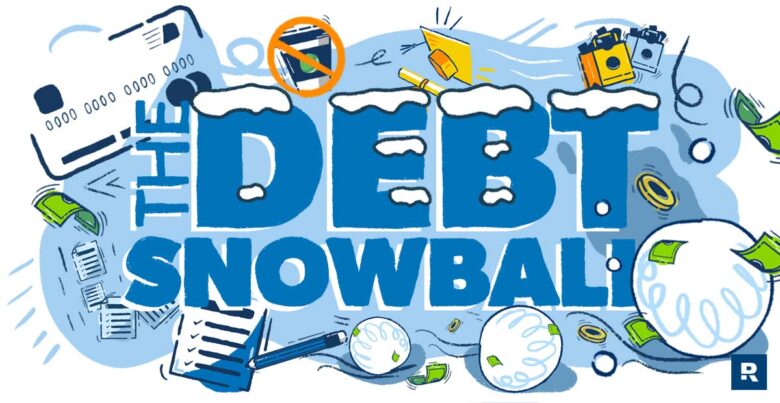Drowning in debt can feel overwhelming, especially when you’re juggling multiple credit cards, student loans, and other financial obligations. The good news is that there’s a proven strategy that has helped millions of people eliminate their debt: the debt snowball method. This approach focuses on paying off your smallest debts first while making minimum payments on larger ones, creating momentum that grows stronger as you progress.
Financial expert Dave Ramsey popularized the debt snowball method, having witnessed countless individuals transform their financial lives using this technique. While it may not always save you the most money in interest payments compared to other methods, its effectiveness lies in its ability to change your behavior and maintain your motivation throughout the debt elimination journey.
Understanding Your Debts
Before you can effectively use the debt snowball method, you need to have a clear picture of exactly what you owe. This means gathering statements from all your creditors and creating a comprehensive list of your debts. For each debt, you’ll need to record the creditor’s name, the total balance owed, the minimum monthly payment, and the interest rate.
Many people avoid looking at their full debt picture because it can be frightening, but this step is crucial for success. You can’t create an effective plan without knowing where you stand. Please take a moment to organize this information in a spreadsheet or notebook, as it will be a valuable reference throughout your debt elimination journey.
Once you have all your debts listed, you’ll arrange them from smallest balance to largest balance, regardless of interest rate. This ordering is what sets the debt snowball apart from other debt repayment strategies. The focus is purely on the dollar amount you owe, not the percentage you’re paying in interest.
How the Debt Snowball Method Works
The debt snowball method operates on a simple principle: pay minimum payments on all debts except the smallest one, then attack that smallest debt with every extra dollar you can find. Once the smallest debt is eliminated, you take the money you were paying toward it and add it to the minimum payment of the next smallest debt. This step step creates a “snowball effect” where your payments grow larger as you eliminate each debt.
After paying off the medical bill, you would take that payment amount and add it to the minimum payment you were already making on the $1,200 credit card. This increased payment helps you eliminate the credit card debt faster. Then, you would take the combined amount you were paying toward the medical bill and credit card and apply it to the car loan, and so on.
The beauty of this system is that your monthly payment toward debt elimination keeps growing, even though your income stays the same. As each debt disappears, you have more money available to throw at the remaining debts, creating powerful momentum that accelerates your progress.
Benefits of Using the Debt Snowball Method
The primary advantage of the debt snowball method is its psychological impact. Paying off that first small debt provides an immediate sense of accomplishment and proves that debt elimination is possible. This early win creates positive momentum that helps sustain your motivation during the more challenging phases of debt repayment.
The method also simplifies your financial life progressively. Each time you eliminate a debt, you have one fewer monthly payment to worry about, one fewer account to manage, and one less source of financial stress. This simplification can significantly reduce the mental burden that comes with managing multiple debts.
Another benefit is that the debt snowball method creates a clear, easy-to-follow plan. There’s no complex mathematics involved or difficult decisions about which debt to prioritize based on fluctuating interest rates. You simply focus on the smallest balance, which makes the strategy accessible to anyone regardless of their financial knowledge or experience.
Potential Drawbacks
While the debt snowball method is effective for many people, it’s not without drawbacks. The most significant disadvantage is that it may cost you more in interest payments compared to other debt elimination strategies. By focusing on balance size rather than interest rates, you might end up paying higher-interest debts over a longer period.
For mathematically minded individuals, this inefficiency can be frustrating. If you have high-interest credit card debt alongside low-interest student loans, the debt snowball method might have you paying off the lower-interest debt first simply because the balance is smaller. This approach could result in paying hundreds or even thousands more in interest over time.
The method also requires discipline and consistency to be effective. If you’re not committed to throwing every extra dollar at your debts or if you continue accumulating new debt while trying to eliminate old debt, the snowball effect won’t work. Success depends on changing your spending behavior, not just following a payment strategy.
Is the Debt Snowball Right for You?
The debt snowball method works best for people who need motivation and psychological reinforcement to stick with a debt elimination plan. If you’ve tried to pay off debt before but lost momentum or gave up, the quick wins provided by this method could be exactly what you need to succeed.
This strategy is also ideal for individuals who prefer simplicity and clear direction over mathematical optimization. If calculating interest rates and comparing different scenarios feels overwhelming, the straightforward nature of the debt snowball makes it an attractive option.
Consider your personality and past experiences with financial goals. Are you someone who needs to see progress quickly to stay motivated? Do you respond well to checking items off a list? If so, the debt snowball method aligns well with these traits and could be your path to debt freedom.
Take Your First Step Toward Financial Freedom
The debt snowball method has proven successful for millions of people because it addresses both the mathematical and emotional aspects of debt elimination. While it might not be the most cost-effective approach in terms of interest savings, its power lies in creating sustainable behavior change and maintaining motivation throughout your debt-free journey.
Success with the debt snowball method requires commitment, patience, and a willingness to change your financial habits. Start by listing all your debts from smallest to largest balance, then focus every extra dollar on eliminating that smallest debt while maintaining minimum payments on the rest. Keep in mind that reaching debt-free status is a journey, not a quick fix, and the debt snowball method offers the motivation you need to persevere.
FAQs
1. How long does it take to become debt-free using the debt snowball method?
The timeline varies greatly depending on your total debt amount, income, and how much extra money you can allocate toward debt payments. Most people see significant progress within the first year and can eliminate all non-mortgage debt within two to five years with consistent effort.
2. Should I include my mortgage in the debt snowball?
Most financial experts recommend excluding your mortgage from the debt snowball and focusing on higher-interest consumer debts first. Mortgages typically have lower interest rates and provide tax benefits that make them less urgent to eliminate.
3. What if I have two debts with very similar balances?
If you have debts with balances within $100 of each other, you can choose to pay off the one with the higher interest rate first. This small modification won’t significantly impact the psychological benefits while saving you some interest.
4. Can I use the debt snowball method if I have irregular income?
Yes, but you’ll need to be more flexible with your approach. Focus on making minimum payments during low-income months and apply extra money toward your smallest debt during higher-income periods.




